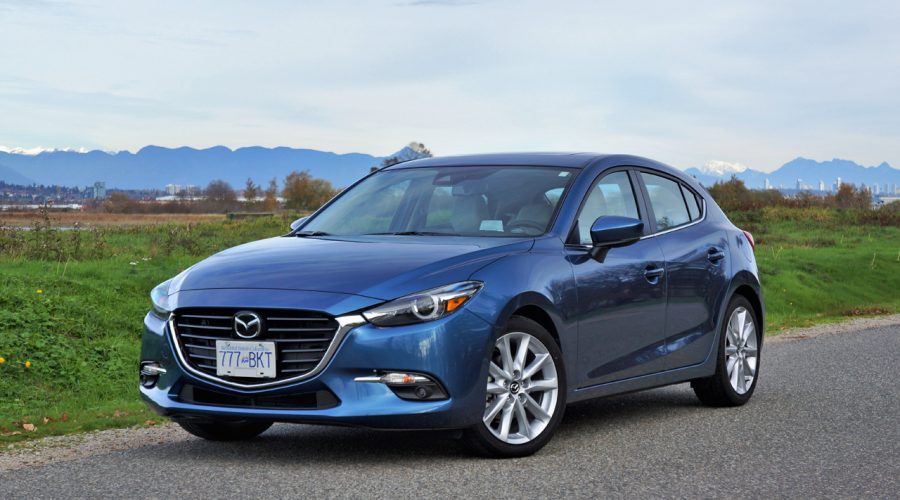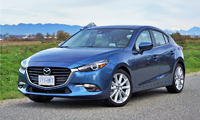
Mazda has a much stronger following in Canada than the U.S. We tend to like smaller, sportier, fuel-efficient cars and SUVs, while our American friends traditionally purchase their vehicles one size larger.
Case in point, from a list of 13 direct competitors the Mazda3 was fourth most popular in our compact segment through 2016, but only ninth in the U.S. I think it deserves better here in Canada let alone its poor showing in the States, but the success of any car is as much about the massive marketing spend of the industry’s big players, as it is quality of goods and value for money. Mazda has long made excellent products that perform better than average and deliver a near-premium look and feel, yet they’re a relatively small independent Japanese brand that doesn’t have the advertising clout of Toyota, Honda, Nissan, the big domestic brands or the Koreans.
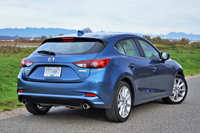
Fans of this alternative import carmaker tend to like Mazda’s more exclusive cachet, especially those who appreciate better than average driving dynamics. I happen to like Mazda’s styling more than most other brands as well, while its interiors are second-to-none within the categories it competes in.
Take this Mazda3 Sport GT. Its deep, wide, chrome-trimmed grille with blackened slats has great style and a totally unique presence on the road, its top corners visually bleeding into this model’s projection LED headlamp clusters, while its sporty yet clean lower fascia incorporates tasteful splashes of chrome, LED driving lights, and the tiniest of LED fog lamps.
The rest of the bodywork flows gracefully from front to back, the car perfectly proportioned despite its compact dimensions, while its backside is finished off with a discrete body-colour rooftop spoiler, elegantly simple LED taillights, and a matte black diffuser-style bumper cap with integrated dual chromed tailpipes at each side. It’s one great looking ride from all angles.
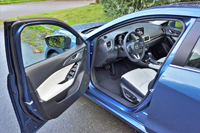
Inside it’s downright premium, especially in my tester’s two-tone black and “Pure White” motif. The dash top, much of the instrument panel, and the door uppers are surfaced in high-quality soft touch synthetic, whereas the door inserts and armrests are finished in padded and stitched leatherette, and the seats get covered in optional perforated leather.
A semi-digital colour TFT primary instrument display is laid out in a sporty motorcycle centre-pod design, while an available class-exclusive head-up display powers up from the dash top to project critical info where it’s easiest to see without taking eyes from the road. At centre, a 7.0-inch fixed tablet-style infotainment display could be straight out of an Audi, BMW or Mercedes, and just like these premium marques it’s controlled with a knurled metal rotating dial on the lower console. Another metal-trimmed dial allows volume control, while an electromechanical parking brake joins an aluminized Drive Selection rocker switch featuring “SPORT” mode next to the leather-clad/satin-silver aluminum adorned shift lever.
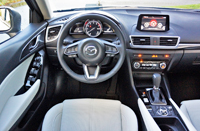
The stylish metallic treatment enhances other areas in the car as well, including the steering wheel that’s also leather-wrapped and filled with high-quality, well damped, tight fitting switchgear, this at least as good as the buttons, knobs and switches on the centre stack that include a nicely sorted dual-zone auto HVAC interface in GT trim.
I almost forgot to mention my favourite steering wheel appendages, a set of paddles for swapping gears. The Sport GT comes standard with a six-speed manual, as do the base GX and mid-range GL, but the GT is the only trim to get paddle-shifters when upgrading to the six-speed automatic. I’ll go into more detail about these and how the entire car drives in my upcoming road test review, the GT also on the receiving end of a more potent 2.5-litre direct-injection, DOHC, 16-valve four-cylinder making 184 horsepower and 185 lb-ft of torque instead of 155 and 150 respectively for the base 2.0-litre four.
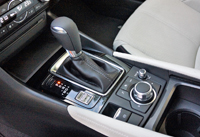
All Mazda3s ride on a fully independent MacPherson strut front and multi-link rear suspension with stabilizer bars at each end, while new for 2017 G-Vectoring Control (GVC) optimizes handling by momentarily retarding engine output when vehicle weight transfers from front to back upon turning the wheels, which shifts weight back towards the front wheels for added traction. This is similar to how racing drivers “load” the front wheels by subtly tapping the brakes before a corner, giving them a cornering advantage, but this automated system goes about its processes completely unnoticed.
Along with all the features mentioned so far, the $26,820 Sport GT includes standard 18-inch alloys on 215/45 all-seasons, auto on/off and auto-leveling headlights, power-adjustable heated side mirrors with integrated turn signals, bright finish window trim, pushbutton ignition, a tilt and telescopic heatable leather-wrapped multifunction steering wheel, a leather-wrapped shift knob, rain-sensing wipers, an intermittent rear wiper, heatable front seats, a wide-angle rearview camera, Bluetooth hands-free phone and streaming audio, a six-speaker stereo, HD radio, AHA and Stitcher internet radio, two USB ports and an aux jack, SMS text message reading and reply, illuminated vanity mirrors, an overhead console with a sunglasses holder, a powered moonroof, a rear armrest with cupholders, 60/40-split folding rear seatbacks, tire pressure monitoring, hill launch assist, Smart City Brake Support sub-20-km/h autonomous emergency braking, advanced blindspot monitoring with rear cross-traffic alert, all the usual active and passive safety equipment, and more.
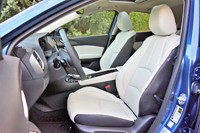
The aforementioned leather upholstery, metallic interior trim, and head-up display comes as part of a $2,900 Premium package that also adds proximity-sensing keyless access, an auto-dimming rearview mirror, a six-way powered driver’s seat with manual lumbar, auto high beams, dynamic cruise control, voice-activated navigation, nine-speaker Bose surround audio, and a slew of active safety features including forward collision warning with high-speed autonomous emergency braking, and lane departure warning with lane keeping assist, these features making the Mazda3 one of only a handful of compact models to achieve a best-possible Top Safety Pick Plus rating.
On top of this my tester is upgraded further with a $1,350 Technology package that boasts adaptive cornering headlights, satellite radio, a HomeLink universal garage door opener, traffic sign recognition, active air shutters to reduce drag and help safe fuel, and Mazda’s i-ELOOP regenerative braking system that first harnesses kinetic energy when slowing or braking and then repurposes into the electrical system for yet more energy savings.
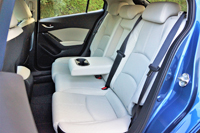
So equipped the Mazda3 GT achieves a claimed 8.7 L/100km city and 6.6 highway, which is considerably better than the regular GT automatic that’s rated at 9.0 and 6.7 respectively—the GT manual gets an estimated 9.6 city and 7.0 highway. Those that prioritize fuel economy over performance can opt for a more basic Mazda3, which gets an 8.4 L/100km city and 6.4 highway rating for the auto or 8.6 and 6.4 with the manual.
I’ll go into more detail about Mazda’s advanced Skyactiv engine and transmission technology in my review, these being critical components of the company’s core ethos of simultaneously maximizing performance while minimizing fuel consumption and emissions, a philosophy that driving enthusiasts can easily get behind…

